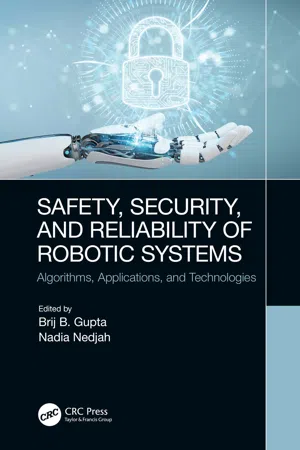Technology & Engineering
Robotics Engineering
Robotics engineering involves the design, construction, operation, and use of robots to perform various tasks. It encompasses mechanical, electrical, and computer engineering principles to create robots that can function autonomously or be controlled by humans. This field is at the forefront of technological advancements and has applications in industries such as manufacturing, healthcare, and space exploration.
Written by Perlego with AI-assistance
Related key terms
5 Key excerpts on "Robotics Engineering"
- eBook - ePub
Safety, Security, and Reliability of Robotic Systems
Algorithms, Applications, and Technologies
- Brij B. Gupta, Nadia Nedjah, Brij B. Gupta, Nadia Nedjah(Authors)
- 2020(Publication Date)
- CRC Press(Publisher)
On the other hand, intelligent mobile robotics deals with the design and implementation of autonomous agents that interact in a given environment through the information provided by perception systems, or knowledge, acting in order to perform predetermined tasks, provided that the field of computational vision ranges from the extraction of visual and geometric features, through 3D reconstruction methods, to the recognition of objects and scenes linked to robotics with respect to land and air robot methodologies, small robot examinations, and robotic simulation systems (Pandey et al. 2017).Robotics is characterized by its extreme multidisciplinary, being seen as the combination of themes inherent in mechanical and electrical engineering, control systems, and computer science, where wireless electronic sensors are integrated into devices with expert systems, with processing aid. Digital imaging still relies on the aid of AI technologies, building real-time object recognition, as it is required for robots or devices active in complex environments and requires computing power to recognize and identify objects, shapes, and people across of images, counting objects, cars, people for traffic applications, pedestrian traffic lights, and roads, among other scenarios (Niku 2020).The integration of computer vision aims to provide data on the positioning of people in the environment according to the visual field and generate the interactive behavior of the robot since the main objective of the area is, in short, the development of autonomous systems capable of operating in a given environment and performing a variety of tasks (Corke 2017).1.4 Technologies for robotics
Generally speaking, AI is a branch of computer science that works to build machines that mimic human intelligence with AI applications by giving machines the ability to perform tasks previously done by one person but often faster and more quickly. Since an intelligent system can recognize the state it is in, it analyzes the possibilities of action and makes the decision on how to act according to its purpose (Hamann 2018). - eBook - ePub
Emerging Library Technologies
It's Not Just for Geeks
- Ida Arlene Joiner(Author)
- 2018(Publication Date)
- Chandos Publishing(Publisher)
Robots have a processing unit, sensors to perceive their environment, and motors and actuators to move their limbs or wheels. They may speak, make other sounds, or flash with lights and colors in response to their environment and instructions that they have been given. They need the ability to follow programmed instructions and not just be controlled remotely.Smart or intelligent robots, on the other hand, can learn from their environments and experience and build on and adapt their capabilities based on that knowledge.They have a range of sensors attached to them as well as their own powerful onboard processors, and significant memory capacity; all of which enables them to reproduce the capacities of the human senses.Just like us, this allows robots to gather information about their environment and enables them to start making decisions for themselves. Smart robots can collaborate with humans, working along-side them and learning from their behavior. They have the capacity for not only manual labor but cognitive tasks.A smart robot can predict human actions with surprising accuracy. Unlike simpler robots that can carry out only preprogrammed tasks, smart robots can observe a person’s movements and make predictions about what they might lead to next.What is Robotics?
Robotics is the field of study that examines robots. It is an interdisciplinary branch of engineering and science that includes mechanical engineering, electrical engineering, computer science, and others. It deals with the design, construction, operation, and use of robots. This field overlaps with electronics, computer science, artificial intelligence (AI), mechatronics, nanotechnology, and bioengineering.Science-fiction author Isaac Asimov is often credited with being the first person to use the term robotics in his short story “Runaround” for the first time in the year 1942. A collection of short stories, I, Robot, was published in 1950.In the story, Asimov suggested three principles to guide the behavior of robots and smart machines. Asimov’s Three Laws of Robotics, as they are called, have survived to the present: - eBook - ePub
Industrial Automation and Robotics
Techniques and Applications
- Kaushik Kumar, B. Sridhar Babu, Kaushik Kumar, B. Sridhar Babu(Authors)
- 2022(Publication Date)
- CRC Press(Publisher)
Any autonomously operated machine that takes the place of human effort, even if that doesn’t seem like a human or performs activities in a humanoid manner is a robot. Robotics is a branch of mechatronics, electrical engineering, and computer science related to the design, construction, operation, and use of robots, as well as the controlling and processing of robots using computer systems. These mechanizations are associated with automated devices that can perform a variety of tasks, activities, situations, and processes in the absence of a person.As technology progresses, the scope of what is referred to as robotics broadens. In 2005, three-quarters among all robots were employed in the automotive industry, constructing automobiles. These robots are generally made up of mechanical arms that are used to weld or screw on automobile parts. Robotics has evolved to include the design, production, and implementation of bots that can investigate Earth’s harshest regions, robots that help public safety, and even bots that aid practically in every aspect of healthcare.8.2.2 FUTURE OF ROBOTICS
Although robotic arms, systems, and equipment have been used in operating theatres since the early 1980s, their potential to aid surgeons with challenging tasks with higher precision is becoming more widely recognized.Generations of people are growing more amenable to these sorts of advancements being employed for life-saving operations as technology continues to expand and evolve.Consider your own arm while bearing in mind industrial robot arms. What is it capable of? It has the ability to bend. It can grip objects (with the help of the hand). It has the ability to lift objects. It has the ability to move objects. Industrial robot arms conduct processes that are similar to those performed by humans; however, they may be more efficient.Industrial robot arms are used in a variety of sectors, including automotive, aerospace, electronics, food and beverage, and construction. These sectors have learned what a growing number of smaller, younger companies are discovering: employing industrial robotic arms for manufacturing boosts productivity.8.2.3 AUTOMATION
The employment of electronics and computer-controlled devices to take control of operations is known as automation. The goal of automation is to increase efficiency and consistency. Automation, on the other hand, replaces labour in the vast majority of circumstances. Indeed, analysts now fear that new technologies will drive up unemployment rates dramatically in the future. - eBook - ePub
- Osondu Oguike(Author)
- 2021(Publication Date)
- Bentham Science Publishers(Publisher)
Robotics Osondu OguikeAbstract
One of the qualities of an intelligent system is the ability to move an object from one place to another. This quality leads to the study of Robotics, which is the aspect of Artificial Intelligence that deals with the study and design of robots. An autonomous robot is a robot that makes decisions on its own, and it shares many things in common with an autonomous vehicle or self-driving vehicle.Keywords: Autonomous vehicle, Effectors, End effectors, Exoskeleton, Germinoid, Humanoid robot, Manipulators.1. FOUNDATIONS OF ROBOTICS
Karel Capek, a Czech novelist, was the first to coin the word robot in a play titled Rossum’s Universal Robots (RUR) in 1920. The word robot means worker or servant in Czech. The term robot means different things to different people; therefore, many people and organizations have defined robots in different ways. In 1979, the Robot Institute of America defined it as a programmable, multifunction manipulator designed to move materials, parts, tools, or specific devices through variable programmed motions for the performance of a variety of tasks. Another definition of a robot, which is not too general and not too specific, is that a robot is an autonomous machine, which is capable of sensing its environment, carrying out computations to make decisions, and performing actions in the real world. From the IEEE community, it was defined as: “A robot is a machine constructed as an assemblage of joined links, so that they can be articulated into the desired position by a programmable controller and precision actuators, to perform a variety of tasks.” Though no definition is perfect, but in any definition of a robot, it must do three things, which are sense, compute and act. A robot senses the world using devices like a camera, sonar, gyroscopes, laser range finders, etc. A robot computes using a small electronic circuit, a powerful multicore processor, or a cluster of networked computers [1 - eBook - ePub
AI & ML - Powering the Agents of Automation
Demystifying, IOT, Robots, ChatBots, RPA, Drones & Autonomous Cars- The new workforce led Digital Reinvention facilitated by AI & ML and secured through Blockchain
- Vijay Cuddapah(Author)
- 2019(Publication Date)
- BPB Publications(Publisher)
The main actions representing a robot’s spectrum of activities fall under ‘Sensing and Actuation’. Sensing involves the perception of the external environment to be processed by the relevant internal mechanisms, both electronic. The response is initiated in the form of a decision passed on to the respective component or part, resulting in an action. This process is called ‘Actuation’.- Robotics involves integration of computers and controlled mechanisms to make devices re-programmable and versatile. A variety of mathematic representations are used to plan robotic tasks and integrate sensors into the task planning. The tasks are the goals to be achieved; for example, go from point A to point B.
- A number of supporting technologies go into the building of the robots such as Vision systems, End-of-arm tooling, Compliance devices,·Manipulation devices,·Welding technologies,·Lasers, Proximity sensors, Wrist sensor (forces/torques), Control sof ware/hardware,·Partdeliverysystems,·Application sof ware,·Interface sof ware, Operating systems, Programming languages, Communication systems I/O devices, etc.
COMPONENTS OF A ROBOT
A typical robot consists of the components such as electronic motors, sensors, power conversion unit, controller, actuators, piezo motors and ultrasonic motors, pneumatic muscle wires, manipulator linkage, base and a user interface, locomotion, and artifi cial intelligence. All these components along with cameras embedded in the place of the eyes and a CPU positioned like a brain enable the robots to undertake many complex operations.Fig 5.1Robots are of the following types- Wheeled
- Legged
- Climbing
- Flying or drones
Mobile robots that can move around like the automated guided vehicle or automatic guided vehicle (AGV follows markers or wires in the fl oor or uses vision or lasers).These robots with manipulator arms are used in a variety of military, industrial and consumer applications. Domestic robots used for cleaning and maintenance are becoming common in developed countries like USA and Japan today.Industrial robots usually consist of a jointed arm (multi-linked manipulator) and an end effector that is at ached to a fixed surface. The International Organization for Standardization defines a manipulating industrial robot in ISO 8373
Index pages curate the most relevant extracts from our library of academic textbooks. They’ve been created using an in-house natural language model (NLM), each adding context and meaning to key research topics.




